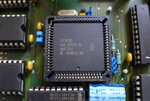hil987
Newbie level 6
Hello all,
I've got an unit that is fitted with M5M51008BP-70LL SRAM memory. I recently went into position where I run out of free space within the chip. Is it possible to upgrade it to a larger size chip?
The processor in the unit is Siemens 80535-N. It also has memory card slot but I was unable to source Panasonic BN-032MC card which appears was the only option for this model.
Looking for a solution to:
1. Backup existing data
2. Expand the memory
May I also note that there is serial connection port at the back of the unit. However, I have failed to establish communication (but it may be bad cable I was using)
I was about to read SRAM chip but I realized as soon as I remove the chip all data will be lost as it needs constant power supply..
Thoughs and ideas?
- - - Updated - - -
Update:
I have now found this line in processor's datasheet:
“The external data memory can be expanded up to 64 Kbytes and can be accessed by instruc-tions that use a 16-bit or an 8-bit address.”
And the SRAM I have appears to be 262 Kbytes if I'm right? So expanding memory no longer is an option.
I'm now thinking of making up SRAM memory card on prototype board. Anyone did this in the past?
I've got an unit that is fitted with M5M51008BP-70LL SRAM memory. I recently went into position where I run out of free space within the chip. Is it possible to upgrade it to a larger size chip?
The processor in the unit is Siemens 80535-N. It also has memory card slot but I was unable to source Panasonic BN-032MC card which appears was the only option for this model.
Looking for a solution to:
1. Backup existing data
2. Expand the memory
May I also note that there is serial connection port at the back of the unit. However, I have failed to establish communication (but it may be bad cable I was using)
I was about to read SRAM chip but I realized as soon as I remove the chip all data will be lost as it needs constant power supply..
Thoughs and ideas?
- - - Updated - - -
Update:
I have now found this line in processor's datasheet:
“The external data memory can be expanded up to 64 Kbytes and can be accessed by instruc-tions that use a 16-bit or an 8-bit address.”
And the SRAM I have appears to be 262 Kbytes if I'm right? So expanding memory no longer is an option.
I'm now thinking of making up SRAM memory card on prototype board. Anyone did this in the past?
